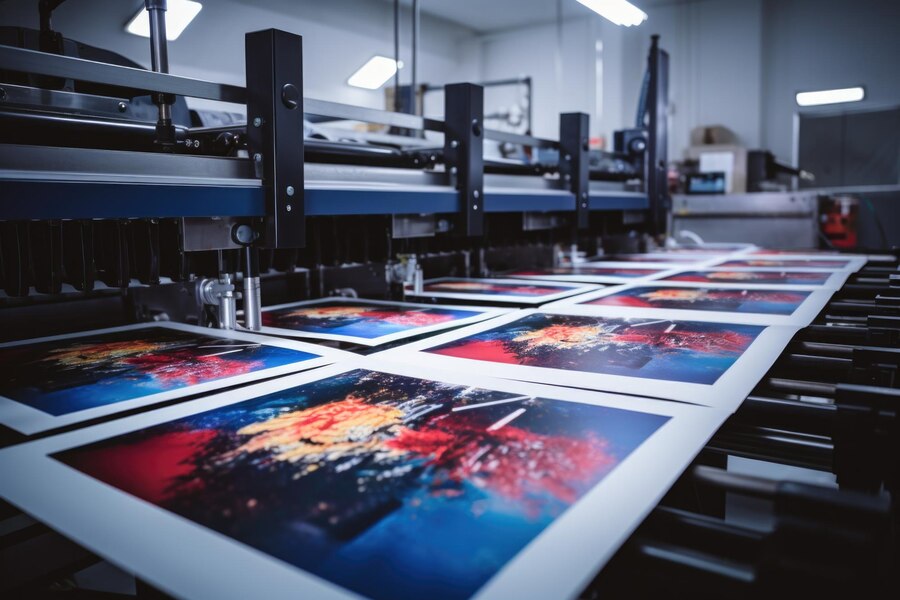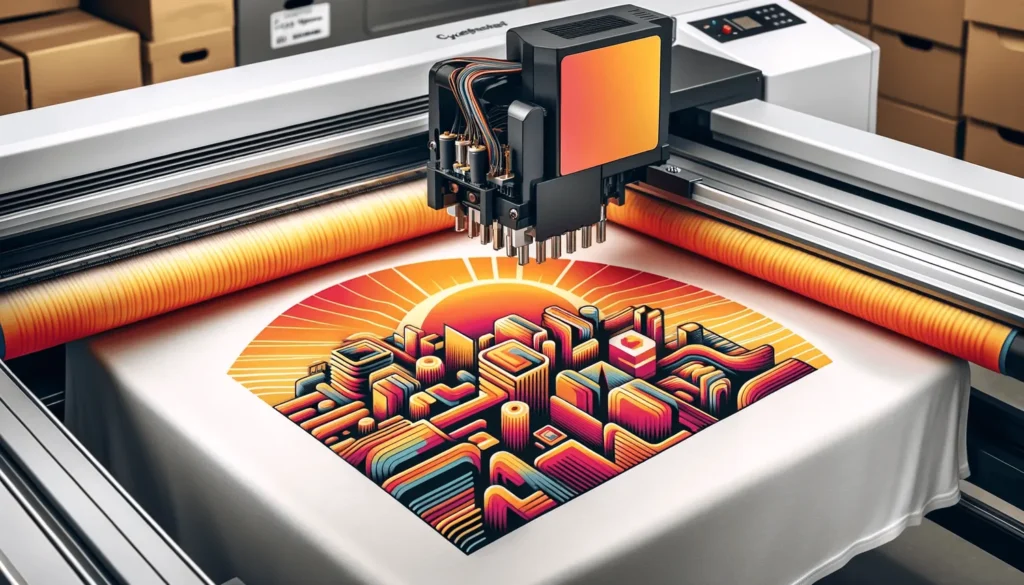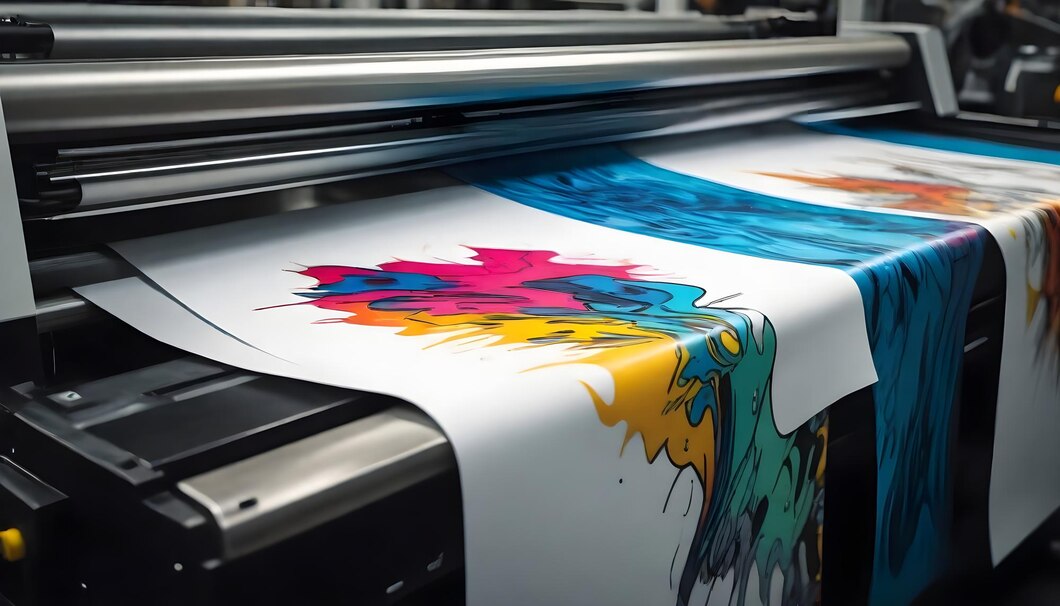Direct-to-garment (DTG) printing is an advanced printing technique that involves printing designs directly onto textiles using special inkjet technology. Unlike traditional methods such as screen printing, which require the creation of screens for each color and design, DTG printing allows detailed, full-color designs to be printed directly onto the fabric in one step. This method is particularly popular for producing small batches of custom apparel and accessories because it offers high-quality results without the need for extensive setup.
DTG printing has revolutionized the custom apparel industry by enabling businesses and individuals to quickly and efficiently produce small quantities of apparel with complex and colorful designs. Whether you want to create a single custom t-shirt or a limited run of promotional items, DTG printing offers a cost-effective and versatile solution.
History of DTG Printing
The concept of DTG printing emerged in the late 1990s as a response to the limitations of traditional textile printing methods. The initial development of DTG technology aimed to simplify the process of printing on clothing and make it more accessible to small businesses and individual creators.
Important milestones in the development of DTG technology:
Late 1990s: The first DTG printers are introduced. These early models were primitive and had limitations in terms of print quality and speed. However, they demonstrated the ability to print directly onto clothing without the need for screens or transfer paper.
Early 2000s: Technological advances improved the capabilities of DTG printers. Better ink formulations and better print heads allow for higher resolution prints and more vibrant colors. The introduction of white ink was a major milestone, enabling printing on black clothing by providing a base layer for other colors to stand out.
Mid-2000s: The market saw the arrival of more sophisticated DTG printers from various manufacturers. These printers offer better reliability, faster printing speeds, and greater ease of use. Software improvements also allowed for better color management and design customization.
2010s: The adoption of DTG printing grew rapidly, driven by the rise of e-commerce and on-demand printing services. Companies began offering web-to-print solutions, allowing consumers to design and order custom apparel online, with DTG printing efficiently fulfilling these orders.
Recent Developments: Advances in printer technology, such as better printheads, more durable inks, and better software, have continued to push the boundaries of DTG printing. Additionally, there has been a focus on making DTG printing more environmentally friendly, with the development of eco-friendly inks and more sustainable production methods.
Overall, the history of DTG printing reflects a continuous evolution driven by technological innovation and the growing demand for personalized, high-quality custom apparel. As technology advances, DTG printing is expected to become even more accessible and versatile, further cementing its place in the modern printing landscape.
How DTG Printing Works
Direct-to-garment (DTG) printing is a sophisticated process that allows high-quality, detailed designs to be printed directly onto textiles. Here’s a step-by-step breakdown of how DTG printing works:

Preparation of design:
The process begins with the preparation of the design in digital format, usually using graphic design software. The design is then converted into a format that can be read by a DTG printer, often by specialized RIP (Raster Image Processor) software. This software optimizes designs for printing, ensuring accurate colors and proper resolution.
Pre-treatment of clothing:
Before printing, the garment, usually a T-shirt, must be pretreated with a special solution. This pre-treatment helps the ink adhere better to the fabric and enhances the vibrancy of the colors. The pre-treated garment is then dried using a heat press or conveyor dryer.
Printing process:
The pre-treated garment is loaded onto the platen of the DTG printer. The printer uses inkjet technology to spray ink directly onto the fabric. DTG printers have special print heads that move back and forth over the garment, applying ink where needed.
For designs on dark fabrics, a layer of white ink is first applied to create a base. This base layer ensures that the colors in the design appear vibrant and do not fade with the color of the fabric.
Print Treatment:
Once the design is printed, the garment must be cured to allow the ink to set. This is usually done using a heat press or conveyor dryer, which applies heat to the garment for a specific period of time. The curing process ensures that the print is durable, resistant to washing, and retains its vibrant colors.
Advantages of DTG Printing
DTG printing offers several advantages that make it a popular choice for custom apparel production:
High Quality Prints:
DTG printing is known for its ability to produce high-resolution, detailed prints. This technology allows complex designs, including fine lines, gradients, and photorealistic images, to be printed with great precision and clarity.
Suitable for complex designs:
Unlike traditional methods like screen printing, which require separate screens for each color, DTG printing can handle complex, multi-color designs in a single print run. This makes it ideal for printing detailed artwork, photos, and designs with multiple colors and gradients.
No minimum order required:
DTG printing is cost-effective for small runs and even single items, as there is no need to set up screens or plates. This flexibility makes it perfect for personalized items, one-off designs, and small batches, catering to niche markets and custom orders.
Environmentally Friendly Aspects:
DTG printing can be more environmentally friendly than other printing methods. Water-based inks used in DTG printing are often non-toxic and biodegradable. Additionally, the ability to print on demand reduces waste, as garments are printed only when ordered, reducing overproduction.
Efficiency:
DTG printers can print on a variety of fabrics, although they perform best on cotton and cotton blend materials. This versatility allows for a wide range of products, including t-shirts, hoodies, tote bags, and other apparel items.
Ease of use:
Modern DTG printers are designed with user-friendly, intuitive software and straightforward maintenance procedures. This ease of use allows even small businesses and individual creators to produce professional-quality prints without extensive technical expertise.
What is Direct-to-Garment (DTG) Printing?
Limitations of DTG printing
Despite its many advantages, DTG printing also has some limitations:

Slow printing process for large orders:
DTG printing is perfect for small to medium sized orders. Printing speeds can be slower than traditional methods such as screen printing, making it less efficient for large-batch production. Each garment is printed individually, which can increase production time for large quantities.
Higher cost per unit for larger batches:
Due to slower printing speeds and individual handling of garments, the cost per unit can be higher for large orders than methods such as screen printing, which can produce large quantities more quickly and economically once the screens are set up. can do
Fabric compatibility:
DTG printing works best on natural fibers, especially cotton and cotton blends. Synthetic fabrics, such as polyester, do not absorb ink as well, which results in reduced colors and reduced print durability. Printing on synthetic fabrics requires special inks and pretreatments, which can add cost and complexity.
DTG Printing vs. Other Printing Methods
When comparing DTG printing to other common printing methods, several key differences emerge:
DTG Printing vs Screen Printing:
Setup and cost: Screen printing requires creating a separate screen for each color in the design, which adds significant setup time and expense. This makes it more economical for large orders but less so for small runs. DTG printing, on the other hand, requires no screen, making it ideal for small batches and custom orders.
Design complexity: Screen printing is less suitable for designs with many colors or complex details due to the limitations of the screen-making process. DTG printing excels in complex, multi-color, and detailed designs.
DTG Printing vs Heat Transfer Printing:
Durability: Heat transfer prints can sometimes crack or peel over time, especially after multiple washes. DTG prints, when properly cured, are more durable and can withstand repeated washing without significant degradation.
Print feel: Heat transfer often leaves a noticeable layer on the surface of the fabric, while DTG prints are absorbed into the fabric, resulting in a softer feel.
DTG Printing vs Sublimation Printing:
Material Compatibility: Sublimation printing only works on polyester fabrics or polymer coated items. DTG printing is more versatile, working best on cotton and cotton blends but also capable of printing on a variety of other fabrics with proper pre-treatment.
Color range: Sublimation offers vibrant colors but is limited to light colored fabrics. DTG can print on both light and dark fabrics, thanks to the use of white ink as a base layer on dark fabrics.
Choosing the Right Fabric for DTG Printing
Choosing the right garment is critical to achieving the best results with DTG printing. Here are some important considerations:
Fabric Type:
Natural fibers, especially cotton, are ideal for DTG printing because they absorb ink well, resulting in vibrant and durable prints. Cotton blends (such as cotton/polyester) can also work well, but 100% polyester or other synthetic fabrics may require special inks and pretreatments.
Dress Color:
Light colored garments are generally easier to print on and require less pre-treatment. Dark colored garments require a layer of white ink to ensure that the colors of the design stand out, which can increase production time and cost.
Pre-treatment requirements:
Adequate pretreatment of the garment is essential for proper ink retention and vibrant colors. Pre-treated garments should be handled carefully to avoid contamination that could affect print quality.
Common applications of DTG printing
DTG printing is versatile and can be used for a wide range of applications, including:
Custom t-shirts and apparel:
Ideal for printing personal designs, logos and artwork on t-shirts, hoodies and other apparel items.
Personalized Gifts:
Great for creating one-of-a-kind gifts such as custom printed tote bags, baby clothes and aprons.
Small Business Equipment:
Small businesses can produce limited runs of branded merchandise using DTG printing, such as employee uniforms, promotional items, and event apparel.
Promotional Items:
Companies can create promotional apparel with detailed, colorful designs for marketing campaigns, trade shows, and corporate events.
Tips for successful DTG printing
To ensure successful DTG printing, consider the following tips:

Dress Preparation:
Always pre-treat fabrics properly and make sure they are completely dry before printing. This step is critical for ink adhesion and color vibrancy.
Choosing the right design:
Use high resolution images and designs to ensure clear and detailed prints. Avoid using low-resolution or highly compressed images that may appear pixelated when printed.
Printer Maintenance:
Clean and maintain your DTG printer regularly according to the manufacturer’s instructions. Proper maintenance ensures consistent print quality and extends the life of the printer.
The future of DTG printing
The future of DTG printing looks promising, with several trends and developments on the horizon:
Technological innovations:
Continuous improvements in printer technology, such as faster printing speeds, better ink formulations, and better color accuracy, are expected to make DTG printing more efficient and of higher quality.
Increased accessibility:
As technology advances, DTG printers are becoming more affordable and user-friendly, making them accessible to a wider range of businesses and individual creators.
Durability:
The focus is on developing eco-friendly inks and reducing the environmental impact of the printing process. Sustainable methods and materials are likely to become more popular in the DTG printing industry.
Market Development:
Due to the growing popularity of e-commerce and on-demand printing services, the demand for personalized and customized apparel continues to grow. This trend is expected to fuel the growth of the DTG printing market.
Summary
Direct-to-garment (DTG) printing is a versatile and innovative method that has revolutionized the custom apparel industry. With the ability to produce high-quality, detailed prints on demand, DTG printing is ideal for small batches, complex designs and personalized items. Although it has some limitations, such as slower production speeds for large orders and higher costs per unit for large batches, the benefits often outweigh these drawbacks.
As technology advances, DTG printing is poised to become more efficient, accessible, and sustainable, making it an increasingly attractive option for businesses and individuals looking to create custom apparel. Whether you’re a small business owner, an artist, or just someone who wants to create unique clothing, DTG printing offers a flexible and high-quality solution for your printing needs.

